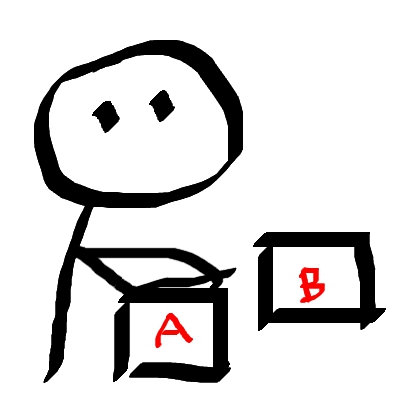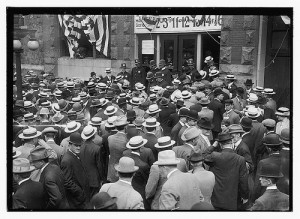Category: Categorizing
Keyword Round-up: April on Academia.edu

Here’s my April keyword round-up from Academia.edu, with an emphasis on “Arguably the Greatest” and imagined communities and sports fans on Wikipedia.
A bit of background: Academia.edu offers scholars analytics data, as well as the opportunity to understand the ways in which their research is being discovered. Using this data, scholars may be able to better frame their research to interested parties. It’s also claimed that this data could help an active academic seek tenure and promotion… I’ll let you know when I get there.
For most of April, I must ashamedly admit, I only had one article posted on my Academia.edu page: “Arguably the Greatest: Sports fans and communities at work on Wikipedia” – a 2009 exploration of the conflict-to-consensus process at work when fans of retired celebrity athletes go to work on framing out these athlete narratives in Wikipedia articles.**
My analytics report shows that four searches performed through Google brought searchers to my Academia.edu page. One of these searches was performed on Google.Au. The search terms were as follows:
- arguably the greatest sport fans and communities at work on wikipedia (Google search rank: 2)
- ‘arguably the greatest ” phrase (no Google search rank)
- meghan arguably the greatest: sport fans and communities at work on wikipedia. sociology of sport journal 26(1): 127-154. (Google search rank: 1)
- “imagined communities” “sports writing” (Google search rank: 1)
I found these search terms particularly interesting as two searches were directly seeking my article. How gratifying! The other two search terms suggest ways in which I could frame my research – and I am most motivated to flesh out my work in relation to imagined communities and sports writing.
Finally, the details about the Google rank of my piece were the most fascinating: this 2009 Wikipedia article is popping up as the first or second Google search result; certainly not what I expected as a referral.
In the next keyword round-up, I will discuss how adding an additional, older article about the ascription of cultural values and extension of performance for retired celebrity athletes has changed the incoming traffic for my page; affecting the relationship of profile to document views.
**Watch this space for a development and revisting of my Wikipedia research space in an upcoming piece.
Summary: 3 Features in Successful Cultural Heritage Outreach Events

The following reflections summarize features of cultural heritage outreach and engagement events I have attended during my recent fieldwork at the Smithsonian Institution. I have selected three overlapping features that appear to have contributed to the success of these cultural heritage events; in an upcoming post, I will also offer several tips for improving upon these outreach strategies.
Crowdsourcing
[Gathering or requestion information and action from the crowd, audience, or user]These engagement events have been predominately in line with a citizen-scientist model or crowdsourcing model. In other words, they have gathered participation on an avocational and/or volunteer basis. They have also operated in systematic ways to collect, refine, populate, and assign values – “doing things” with materials. The events have not necessarily been science-focused, though some have been. Most have required participants to BYOD and register for participation. Several of the events have also gathered experiential information and viewpoints from participants at the close of the event.
Participatory
[Audiences or individuals “opting in” toward a goal, either personal or collective]These outreach events have been based around the idea of a shared experience of working toward a project goal – calling upon a sense of participatory culture or being creator-consumers. That means that participants have been taking actions (“doing”) toward both individual projects and shared roles or group work toward parts of a goal, whilethe event has taken participants toward achieving a collective goal in the end.
Free but exclusive
[No charge but cost of time and some bounding on event]Each of these events were held by cultural heritage institutions and were free to attend; yet, the events were also managed in a way that was bounded in number, space, or access. Clarifying my use of “exclusive” to mean selective in this context, the events have typically accepted the first candidates for participation and allowed those individuals to feel as though they are gaining unique access in some way.
The three features discussed above appear to have subtly informed approaches and agenda; and resulted in events that appeared to be reasonably successful.* Enthusiastic and engaged participants were found at all events and activities taken toward each event’s stated goals.
Despite the appearances of success for these events, each event offered several points at which engagement or efficiency could be improved. Watch this space for an upcoming post that speaks to four ways best practice at cultural heritage outreach events can be built.
*This assumption made without knowledge of each event’s stated metrics for success.
**Image of crowds outside the entrance of the 1912 Republican National Convention held at the Chicago Coliseum, Chicago, Illinois, June 18-22, 1912 – shared from George Grantham Bain Collection (Library of Congress) – via Flickr Commons
Crowdsourcing and Engaging Users
This presentation shares the thinking I’ve been using to frame some of my recent work: relating to crowdsourcing and engaging users in transcription of digitally archival material and communities of practice on Wikipedia. With this Prezi, I delivered an information briefing to decision-makers at Smithsonian Institution (SI) in mid-March. This is an on-going, work-in-progress situation that seems to offers great opportunities to improve upon and expand crowdsourcing in exciting ways at SI.
I’d like to take up the call to “show my work” and commit more clearly to open data and open cultural data, which would include sharing steps on how to get to conclusions.Please get in touch if you have thoughts or feedback on these guiding principles – or the tools I’ve discussed.
Categorizing: A second but interrelated process for making knowledge

Categorizing is another process for making knowledge. As a series of steps, categorizing not only compliments making choices; it is built into the process of making choices. Perhaps we should also use the term “classifying” to start, rather than categorizing. Examples of classification abound in science, library and archival practice, and even social relationships. Can you recall the scenes in Mean Girls and Ten Things I Hate About You, in which helpful social gatekeepers identify relevant groups of high school students to a new student unfamiliar with these groupings?
Categories or classes are socially constructed—quite literally in the last example—and decisions and divisions are implicit in the process. Perhaps more importantly, the socially constructed nature of categories and classes means that they can be changed – and by people. Finally, categories and classes are built by making differences between things (items, concepts, words, people); and successfully defining difference, Hall (1997) reminds us, is an act of power but one that is part of a dialogue. Regularly reinforced and resilient power, yet not fixed (socially constructed!). Finally, classifying is essential to culture and meaning, where an order is established by relating things to one another.
So let’s review: categories and classes are divided by and bounded through socially constructed definitions and through specific language choices.
Taking that forward, we can think about the process of categorizing in relation to what we’ve discussed before about making choices. Specifically, that excluding or including things in choices creates relationships of value between what is included and excluded; these hierarchical relationships are rooted in language, which conveys meaning and is as adaptable as the social value it suggests.
As categories are established, relationships between categories are also built. Then as an individual or an institution approaches an item that requires classification, s/he/it will consider what is known from existing systems of knowledge. Thus, it takes meaning to make meaning.
Consider Bishop & Jaworski’s (2003:3) take:
“Academic study, but in fact all aspects of experience are based on acts of classification, and the building of knowledge and interpretations is very largely a process of defining boundaries between conceptual classes, and of labelling those classes and relationships between them.”
Bishop & Jaworski (2003) go on to suggest that language is the central means through which classification becomes possible; thus language itself loses neutrality, while becoming a “key ingredient in the very constitution of knowledge.”
Most recently, I have been considering the ways the categorization process might be built into the process of devising strategies for crowdsourcing. It’s been a bit chicken-or-egg in several senses: i.e. do we build the classification process into the experience or and can we even appropriately engage people without understanding the ways they might want to classify or use and access categorized information? So many things to consider – and, as needs may develop over time, how might we create a flexible and responsive but reliable means of categorizing information?
Return to the previous examples I’ve suggested for knowledge building in the digital realm, which I’ve listed again below. Can you pick some moments of categorization here?
- the collaborative process of editing on Wikipedia
- educational institutions and crowdsourcing information about unidentified women scientists, as with the Smithsonian Institution Archives http://siarchives.si.edu/blog/annual-call-help-identifying-women-scientists
- the ways fans of tv dramas on social media platforms share/reblog/retweet, discuss, and debate plot and pieces of news, then reference relevant pieces of information to create an “accepted” group understanding – such as an important event, a character’s motivations, screenwriter and actor/tresses decisions and more
- and even tagging posts on Tumblr and Twitter to first organize information and secondly, make that information more easily identified by others using searching tools and services
References:
Bishop, H. & Jaworski, A. (2003). ‘We beat ‘em’: Nationalism and the hegemony of homogeneity in the British press reportage of Germany versus England during Euro 2000. Discourse & Society, 14(3), 243-271.
Hall, S., (Ed.). (1997). Representation: Cultural representation and signifying practices. London: SAGE Publications Ltd.

